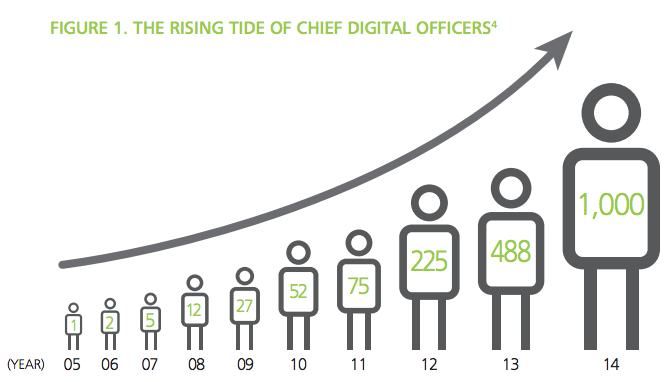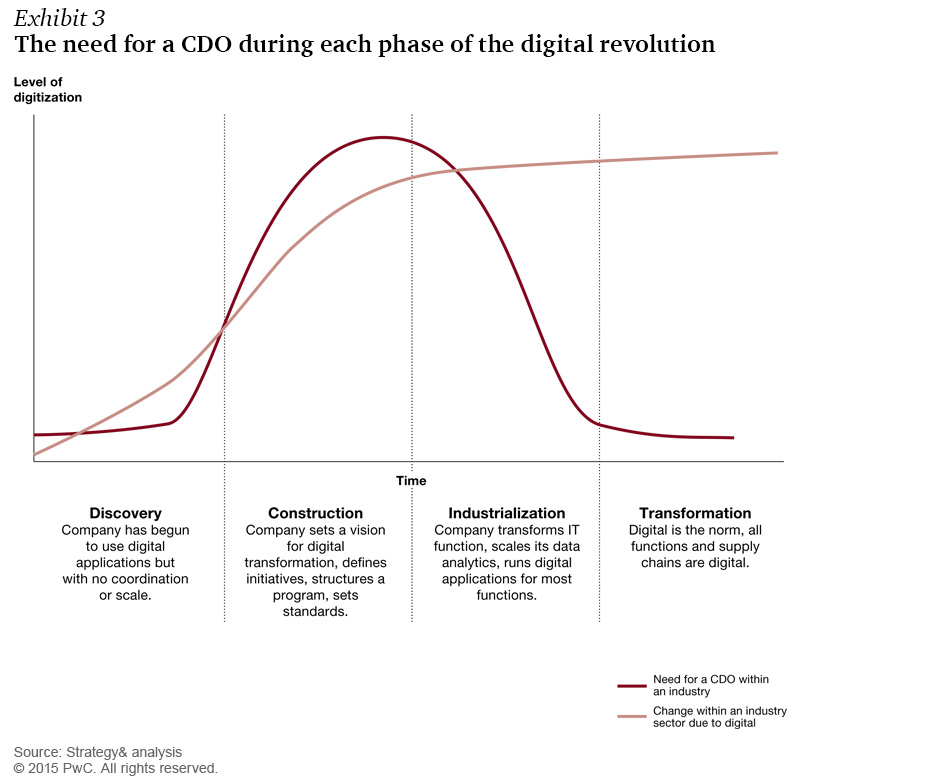Guest blog by Jonas Vandenbruaene, business-engineering student at the University of Antwerp.
However, just a few decades later the position became obsolete. Electricity quickly became well established and the introduction of a centralized electricity grid with synchronized voltages and frequencies solved all problems that kept a CEO awake at night. After just a few years, this great business innovator got sacked.
A new kid in town
Today, we witness a revolution of the same order of magnitude: digitalization. While digitalization offers awesome innovation opportunities for virtually every company, well-established businesses can easily lose their competitive advantage if they are reluctant to change. To take full advantage of digitalization without getting lost, business leaders are hiring experienced Sherpas to get them up the digital slopes: chief digital officers (CDO).
The CDO is a new kid in town that is quickly gaining popularity. According to Deloitte, the number of Chief digital officer positions worldwide has increased from 1 to 1000 in the last 9 years.

Many observers draw a parallel between the electric and the digital revolution. While the CEO was introduced to make sense of electrification, the Chief digital officer is introduced to make sense of digitalization. Question is, will the CDO suffer the same fate? Will the CDO become an invaluable and permanent C-suite member, or will the function become obsolete once digital has been incorporated into the company DNA?
Two questions come to mind:
-
Will a digital transition be as definitive as an electrical one? Meaning virtually no attention or innovation is needed after a digital integration.
- When constant attention and innovation is needed, who is going to make sure it happens?
The answer to the first question is straightforward. The electrification story is a nice analogy of today’s revolution, but electricity is merely an energy input. Digitalization is a vast hodgepodge of new developments in multiple directions that will impact companies on a strategic level. Continuous improvement will be necessary as the technology will continue to change and the stakes are too high.
Will the real CXO please stand up?
The last question I want to address in this blog post is who is going to get his/her hands dirty. There are mainly three possible scenarios.
-
The entire C-suite will integrate all aspects of digitalization in their responsibilities; there is no need for a CDO. The CEO will strategically navigate the company through the digital seas, the CMO will construct the appropriate big data systems to create a 360° view of the customer and so on. Digital will become a fundamental part of every corporate strategy and change the way we do business. Creating a separate role for it would be as silly as creating a separate Chief Smartphone Officer. It makes no sense to establish a new team for innovation, as it is a key responsibility for every member of the C-suite.
-
By creating a CDO position the responsibility for continuous innovation could even shift from the entire C-suite to the CDO. In this scenario, innovation is being taken care of in one department so everyone else can keep on doing business as usual. This is not an improvement; it is a denial of the true nature of digitalization
In this scenario the role of the CDO is temporary and transitional. The CDO is a strong motivation and a change manager with a clear vision. He transforms a traditional, cumbersome company into a dynamic and agile organization. The need for a CDO diminishes with digital maturity: once he has induced a culture change in the organization his position becomes unnecessary. After the disappearance of the CDO, the entire C-suite will become responsible for the challenges of digitalization like in scenario 1.
(PWC)
- A new, permanent C-level position will be created. Question then quickly becomes: which one? Over the last decade several new digital related positions have been brought into existence i.e. Chief Digital Officer, Chief Data officer, Chief Analytics officer, Chief innovation officer... There still exists a lot of ambiguity about the exact definitions. Schmitz predicts the Chief Digital Officer will replace the Chief Information Officer over time, others predict otherwise. What is certain however is that companies will have to continuously reinvent themselves in order to survive. Time will tell which new C-level positions will be most suited to take on this challenge. For the others, there will be no other choice than to join the collection of outdated jobs, just like the man in the picture at the top of this article. He was an aurally gifted sky surveillant before Radar technology ruthlessly took his job. But hey, we can have a laugh at it now!
What scenario do you prefer and why? What are your thoughts? Leave your comments in the section below!
In my next article I will dive deeper into the responsibilities of the new C-level positions in an attempt to clarify any ambiguity.
Guest blog by Jonas Vandenbruaene, business-engineering student at the University of Antwerp. Passionate about data analytics, art and traveling the world. Currently writing his master’s thesis on data maturity in organizations and the role of the CDO. Blogging to fuel interesting discussions!